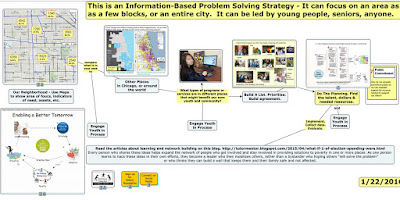As I viewed this some of the graphics and articles from this blog came to mind. Below is one concept map, that focuses on filling high poverty neighborhoods of Chicago with mentor-rich non-school programs that reach kids when they are young and provide on-going support through high school and on to jobs and careers. What are all the things we need to know, and do, to make that happen, not just in a few places, but in every poverty neighborhood in the region?
This is a complex problem, and if you'll take some time over the next few months, you can read articles that I've posted since 2007 that focus on this problem. If you're an educator, or lead a non-school program or a youth program at your church, synagogue or mosque, you could lead young people to these articles, and encourage them to apply the thinking to innovate solutions.
 |
| 4-part strategy |
As you skim through you'll frequently see the graphic at the left, which shows four steps that need to be included in any innovation and problem solving strategy. Read about this in this presentation.
You'll also see presentations, like this one, that focus on each of the graphics in the concept map above.
This past week the annual National Conference on Volunteering and Service was held in Seattle. Due to lack of funds I've not been able to attend this for many years. I try to follow on-line sessions when they are available, and engage on Twitter or Facebook. If you search for this #serviceunites hashtag you can see some of the information posted and try to connect with the people who are sharing that information.
I last attended in 2008 and I created the graphic at the right as part of a week of articles that I wrote following the conference. In this case I'm emphasizing the use of information, and maps, which is part of the information needed that I refer to in step 1 of the four-part problem solving strategy.
I'm also showing how leaders in business, religion, media, education, politics, etc. (the village) can be drawing people together to use the information to innovate ways to make more and better youth supports available to k-12 youth in all high poverty areas of Chicago or any other city.
While I'm not able to be physically present at most meetings and conferences that focus on poverty, inequality, violence prevention, education, workforce development, youth, tutoring, mentoring, etc. my ideas and the resources I've aggregated for more than 20 years are available 24 hours a day to anyone who attends these meetings, or to all the other people who can't attend, or are not invited.
The real question is, "How much do you care about these problems, and how willing are you to spend time on a consistent bases reading articles and viewing videos that give you a deeper understanding of the problem and potential solutions?"
Can you look in the mirror at the end of each day and check off actions you've taken?
Are you also writing about this? I'd love to find blog articles on web sites of Chicago youth organizations showing how they were reading and reflecting on articles I write, and how they are innovating ways to bring solutions to their own neighborhood, or to other neighborhoods, in Chicago or around the world, where others need help.











No comments:
Post a Comment